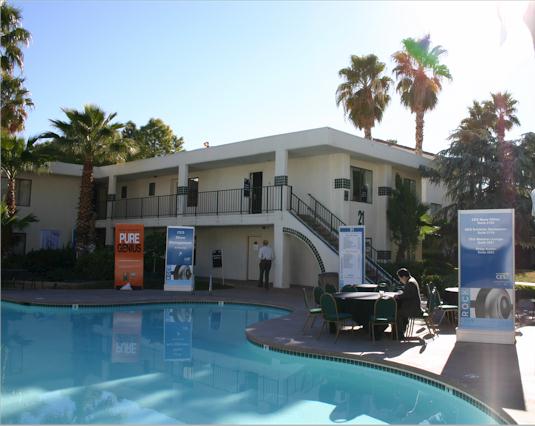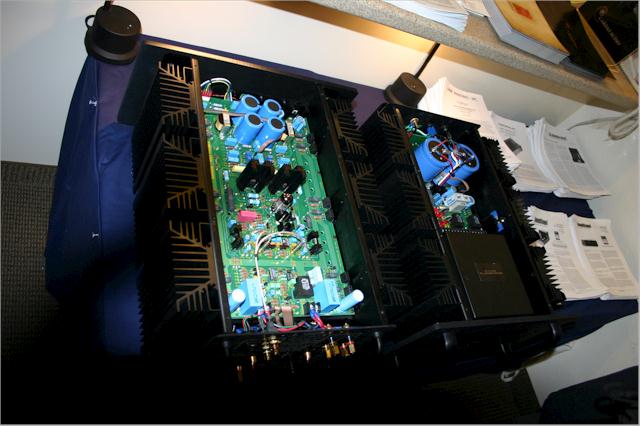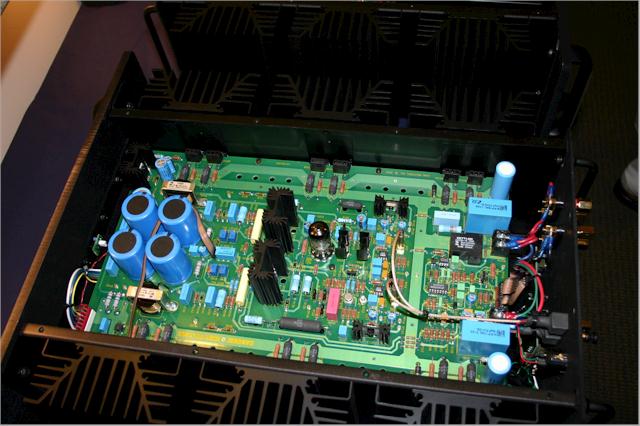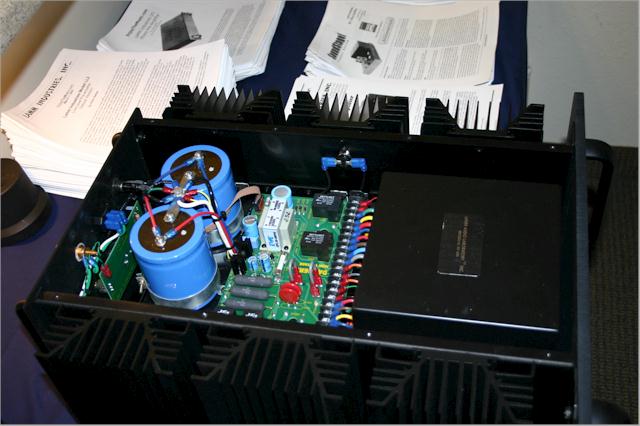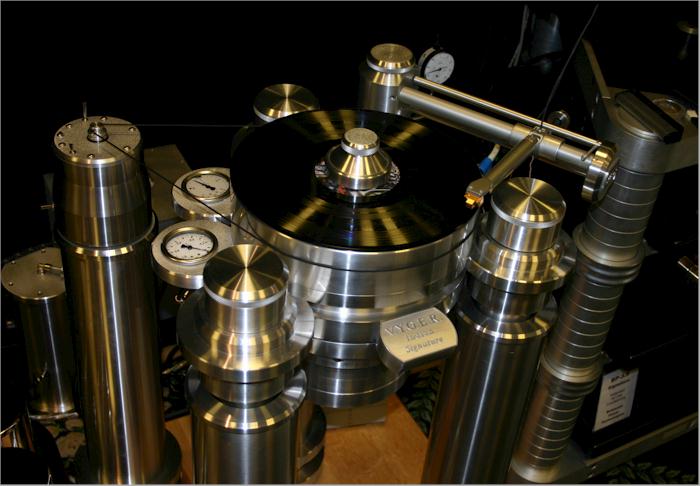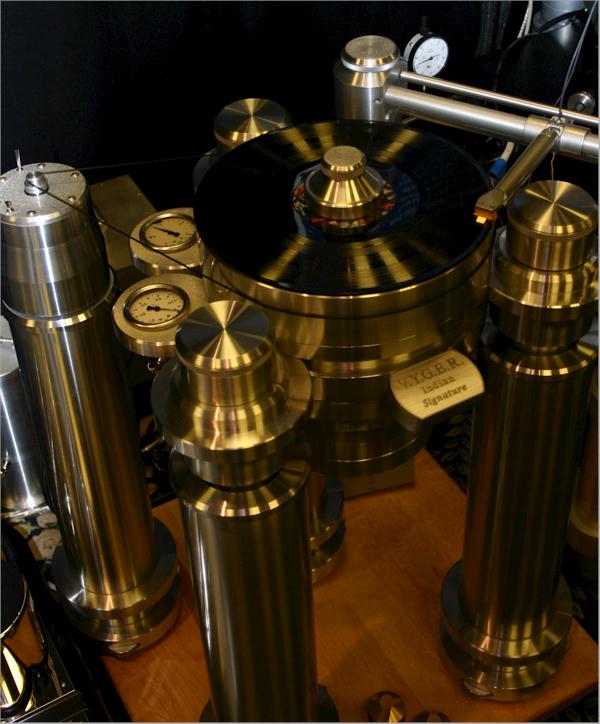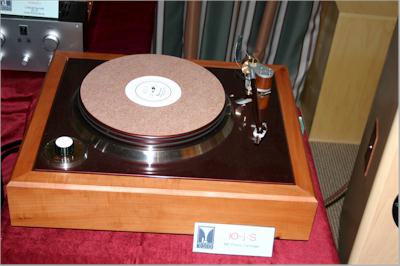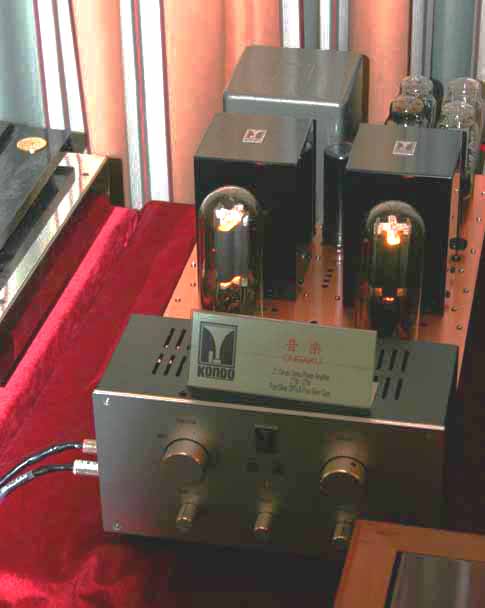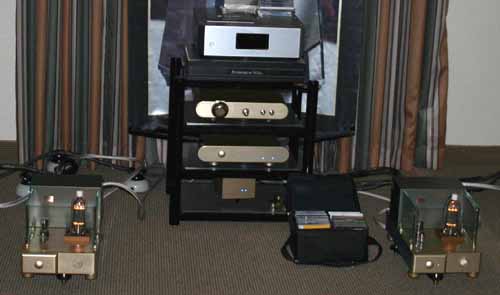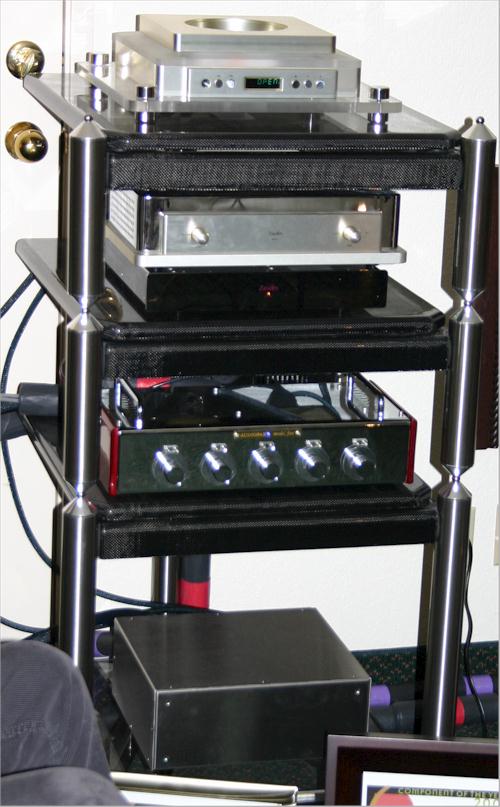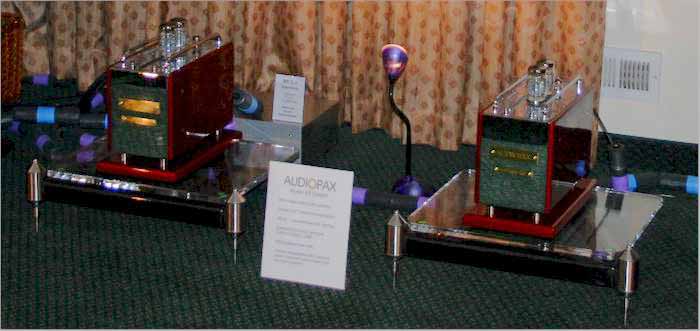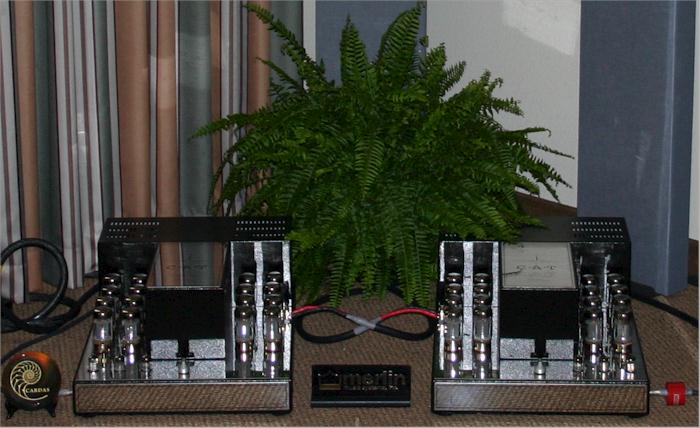|
|
Audio Federation
Sights & Sounds
Copyright
© 2004 Audio Federation, Inc.
The 2004 CES and
T.H.E. Show Reports
High-end Home Audio
Conferences
Las Vegas, Nevada
January 2004
|
This is a highly opinionated
review - this is what we heard, at a show, in a hotel
room, from a hastily set up system.
This show report emphasizes
the rooms that either sounded the best or exhibited very high-end
equipment, the tip-top state-of-the-art. If we had time, we would have
loved to visit each and every room and spend the time to play our test CDs
and chat with the exhibitors. But because time is so limited compared to
the large number of exhibits, we decided to sample the icing (yum!) and
leave the cake for another time. This approach is fraught with the peril
of missing something significant -- not being exhibitors (who usually just
want to go home after the 4 grueling days), we wish that CES lasted long
enough for us to hear every room.
We are dealers for
Acapella Audio
Arts, Accustic Arts,
Acoustic Dreams, Audio Aero, Audio Note U.K., Edge Electronics, HRS
(Harmonic Resolution Systems), Lamm Industries, Loricraft, Lyra, Magic
Diamond Blue, Marten Design, Nordost,
RixRax, Shunyata Research,
Sound Lab,
and
Walker Audio..
We do try to be as honest (and some may say ruthless) as always regarding
our reporting about the sound of these lines at the conferences, whether
they sounded fantastic or completely sucked, but we must necessarily hold
back (some :-) on our exuberance, or perhaps even disappointment, in the
name of good taste, when referring to these lines or their direct
competitors.
| Another year, another CES...
The quality of the rooms this year was
high, not too many with runaway ear-bleeding treble (though there were
some problems at the other end of the frequency spectrum), but no room
stood out head-and shoulders above the others.
The theme for us
this year were: 'real sound' versus 'nice sound' and the fuller sound
of larger speakers versus the ease of taming the bass of smaller
speakers
There were many rooms that had 'nice' sound this year - not too
bright, melodic, somewhat PRaTly, timbre pretty good, pleasant to
listen to... but many times the music did not sound like it came from
real musical instruments. |
 |
Often this was because the
note envelope - the shape of the magnitude of each frequency of a note as
it springs into being, swells, and decays - has been altered so much it is
almost unrecognizable as originating from a real, physical musical
instrument at one time.
This, sometimes unpleasant,
sometimes melodic, result may be the result of the notes being smoothed
out in order to prevent any brightness from occurring by a component or
speaker; the notes being compressed because of design limitations; because
the note's leading edges (and sometimes trailing edges) have been
emphasized to enhance the sense of massive amounts of detail which has a
tendency to impress potential buyers; because the notes are jangled up and
mixed up with other notes due to design limitations; or the intentional
sacrificing of micro-dynamics in order to achieve, perhaps by accident,
the 'wall of sound' that some people prefer to hear in order to
maximize average decibel output.
Note that all of these
goals that result in this homogenization of music into sound
are laudable in some circles and appeal to particular audiences who do buy
audio equipment. To each their own.
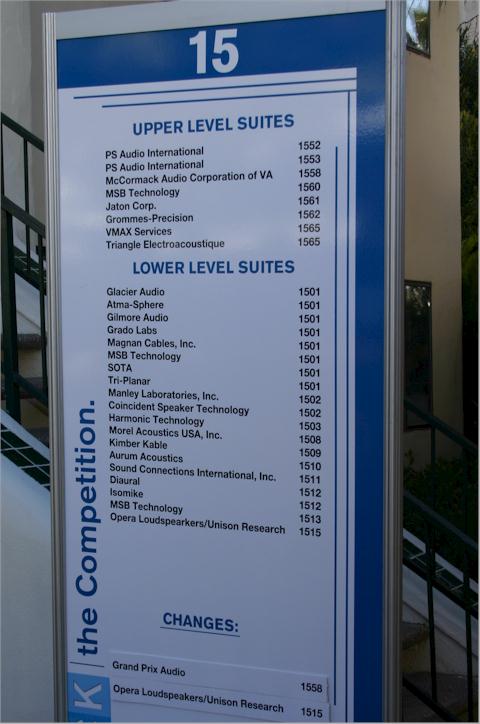 |
Another
theme for us this year had to do with the size of the speakers. Our
preference is for lots of body and fullness and real-sized soundstages
- and this can be achieved by speakers with sizes, for us, as small as
the Coltrane and Watt/Puppy - but rarely smaller.
But fitting big speakers into hotel-room
sized rooms can be quite difficult. Many rooms this year had bass that
was boomy, uncontrolled, and difficult to listen to (the only one we
reviewed here was the room with the big Wavacs - their midrange being
quite impressive).
Many exhibitors were able to tame their
speakers and produce reasonable bass texture, control and slam. But
the question remains: should exhibitors be encouraged to use smaller
speakers, ones perhaps more suitable to the sizes of the rooms?
Maybe, but not by us. We like the
big sound.
|
Lamm / Damoka Room: Lamm / Weiss Medea / CES / Wilson
Audio

Lamm M1.2 Reference monoblock hybrid amplifiers, L2
reference preamplifier, Weiss Medea DAC, CEC transport, Wilson Watt/Puppy
7 speakers
|
Nice, controlled,
dynamic (micro and macro), deep soundstage (if perhaps a little
recessed). A little dry in the upper-midrange. Controlled yet musical,
the Wilsons sounded good but, typically, without that 'ease/warmth'
that other speakers have. The system was set up so that either a pair
of the new M1.2 Reference 100 watt monoblocks or a pair of the new
M2.2 200 watt monoblocks could be used. |
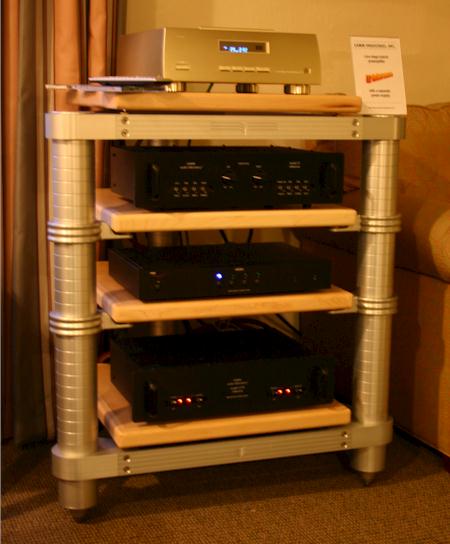 |
The Hovland /
Wilson Room
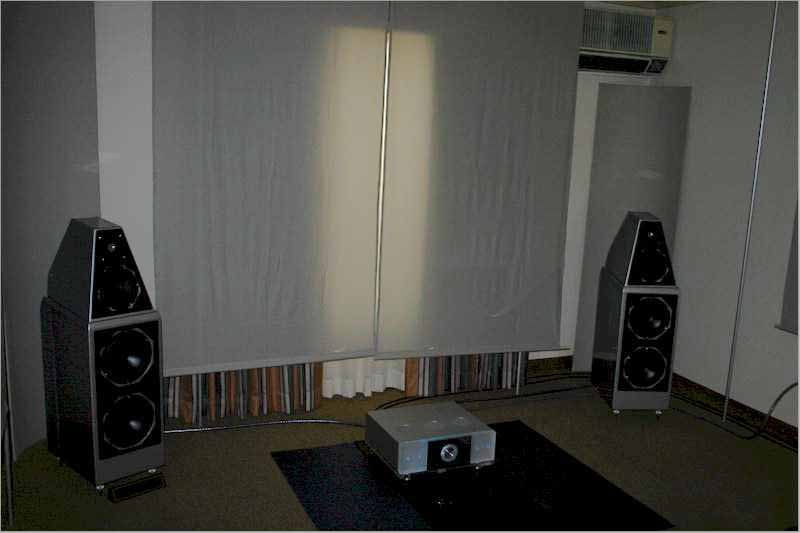
Sweet and detailed in the lower midrange and lots of air,
the Radia was able to show off its pure, lovingly detailed musicality.
Unfortunately, the midrange was somewhat dry and scratchy, it sounding as
if the Radia was not able to over-power the tendency of the tipped-up
midrange of these speakers to overwhelm the rest of the music. This system
may also have been a little weak in the bass - or perhaps it was just the
desire for a more fuller, relaxed sound - which is so hard to get with the
Wilsons.
|
|

HP 200 preamplifier and Dodson
DA-218 DAC. |
|

The ever so lovely Hovland Sapphire
amplifier. |
|
Joule Electra / Joseph Audio Room
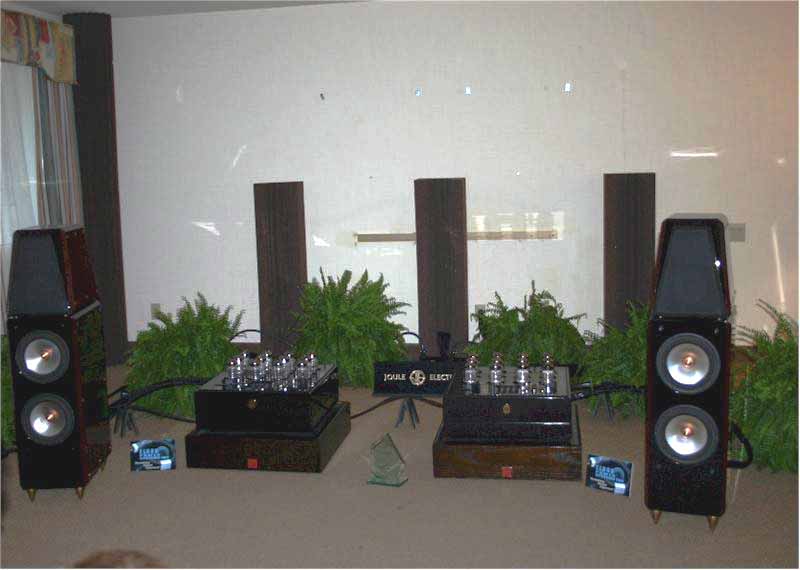
Very engrossing and enchanting, but the Josephs still have
that very apparent metallic midrange tinge that especially shows up in
music that contains instruments like banjo and guitar. The bass was very
present and forceful, but slightly uncontrolled and somewhat distracting -
perhaps due to room issues, and the old Audio Aero Capitole MK I that was
used does not excel in the bass control category either. The note
envelopes were not always perfect, leaning toward the romantic side - and
the top-to-bottom frequency response was definitely not flat. But...we
gave this room Favorite of Show.
We heard some vinyl and one
of our test CDs - and there is an special enchantment to this system.
|

Audio Aero Capitole Mk I, Joule Preamp, Elrod Power
Cords, Walker High Definition Links |
After a minute or so
the listener is drawn in and taken on a little journey to a far-away
land...
The interplay play of
(slightly unnaturally rich) harmonics, the powerful (also slightly
unnatural) bloom of each note in combination with the vibrant,
toe-tapping rhythm, gave a playful (as opposed to formal or pompous)
majesty to the music being played.
There is not only
majesty, but suspense with this system... The sense of the musicians
playing off each other was very apparent, and I found myself in
delightful anticipation of the next note, almost as if I was one of
the musicians myself. Very nice.
And, boy, it sure got a
little hot in this room sometimes! They'd have to turn on the
air-conditioning... and then a quiet piece would be played, and they'd
have to turn the noisy thing off again. The trials and tribulations of
lots of tubes. |
Globe Audio Marketing Room: Audio Aero / Wilson Benesch
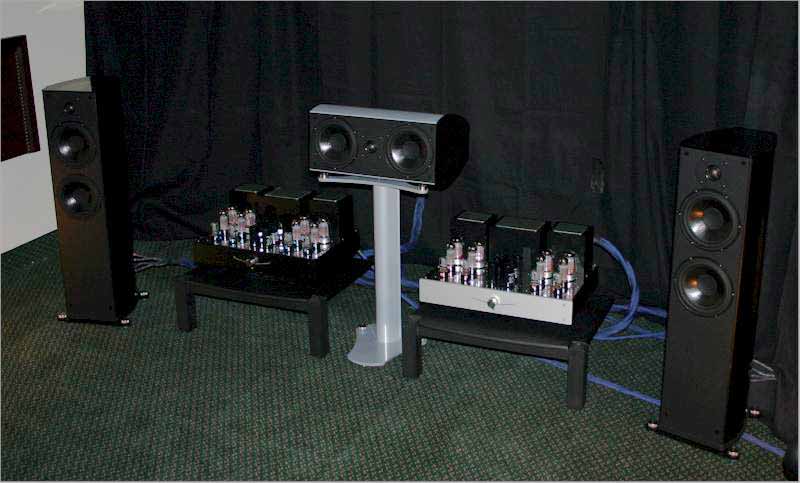
The Wilson Benesch speakers are not our cup of tea, usually sounding flat
and lacking both macro and micro dynamics and harmonic richness - but this
system was engrossing and full-bodied with a the slightest touch of warmth
and lushness. The prototype Audio Aero Prestige appears to have more
detail and micro-dynamics than the Capitole MK II, even on redbook CDs.
Overall - the sound was very nice and straining at the limitations of the
speakers.
The speakers were set up in
a small, darkened, oddly-shaped room in a 5-channel configuration. The
5-channel demo CDs were actually quite nice, augmenting rather than
distracting from the (essentially 2-channel) music presentation - creating
a deeper, more solid soundstage when enabled, collapsing the soundstage in
both width and especially depth when disabled.
|
The prototype Prestige
is more lively than the EMMLabs or even the Audio Note DAC4.1x/CDT-2 -
with more analog-like micro- and midi-dynamics (always the Audio Aero
CD player's forte). The Audio Aero Capitole amps helped generate a
very solid image/soundstage and added their own special slightly
golden lushness. |
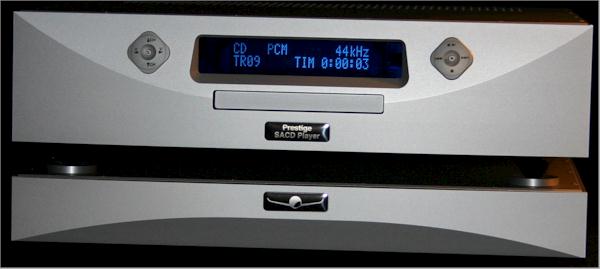 |
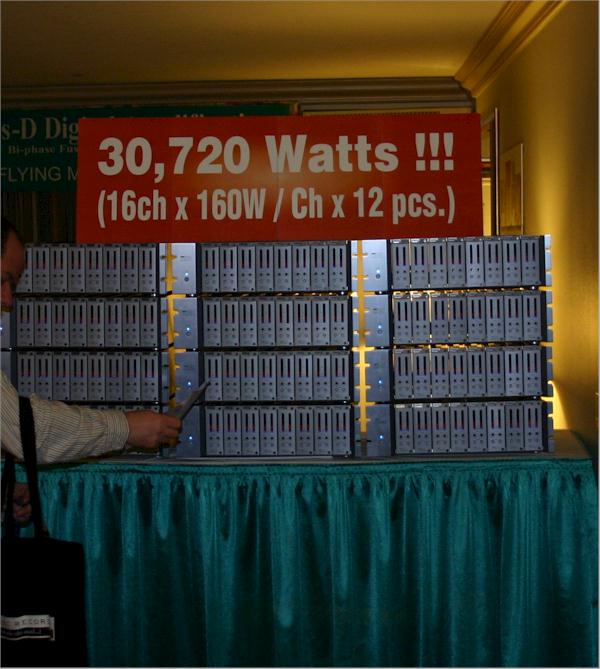
We didn't get to hear this (these) amps...
Marten Design / EAR Room #1
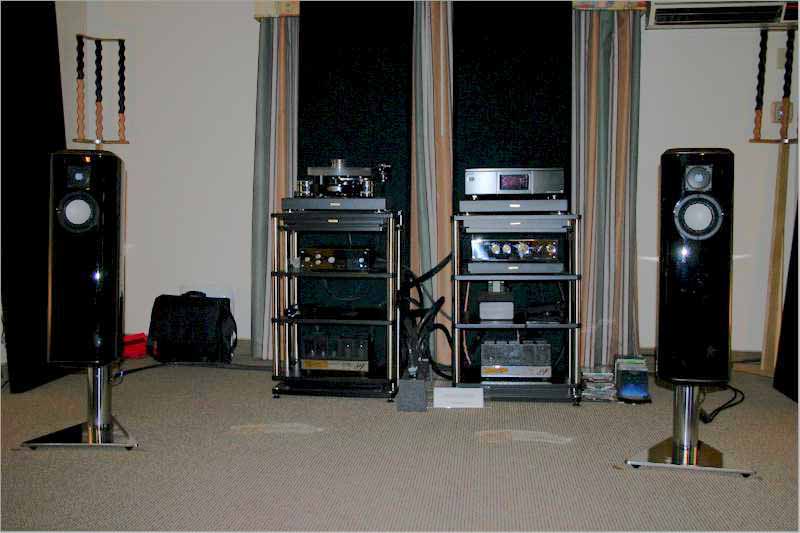
Sony CD player, EAR electronics, Marten Design Alto Coltrane speaker
|

Underneath the Alto Coltrane we see the bottom-firing
9" ceramic woofer
|
Marten Design out of
Sweden introduced their new Altos-Coltrane speakers at CES. This
system was a nice solid performer, up and down the audiophile
checklist.
The Sony SCD-777ES CD
player, and the brand-new Origin Live turntable somewhat limited the
overall musicality of the system, which had just a smidgeon less
micro-dynamics and finesse than we like.
The Altos also appeared
to be missing a touch of the air and fullness of the sound of the
Altos' bigger brothers, the Coltranes, which makes sense, given the
smaller size of the Altos and the Coltrane's possession of that
Accuton diamond tweeter.
|
|
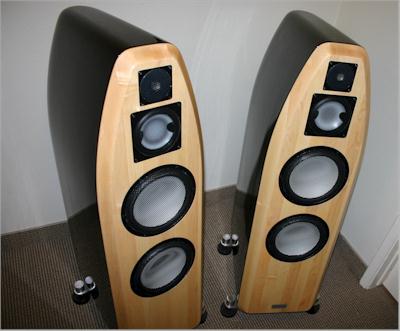
The Marten Design Coltranes in light maple finish on
static display
|
Marten Design / EAR Room #2

MSB, Marten Design Mingus speaker, MSB CD player
|
These speakers are very
similar in sonic signature to their bigger bothers, the carbon-fiber
enclosure speakers.
Albeit with less
fullness and body and less authority up and down the frequency band,
the musicality and attention to the details of musical nuances always
showed through with these speakers. |
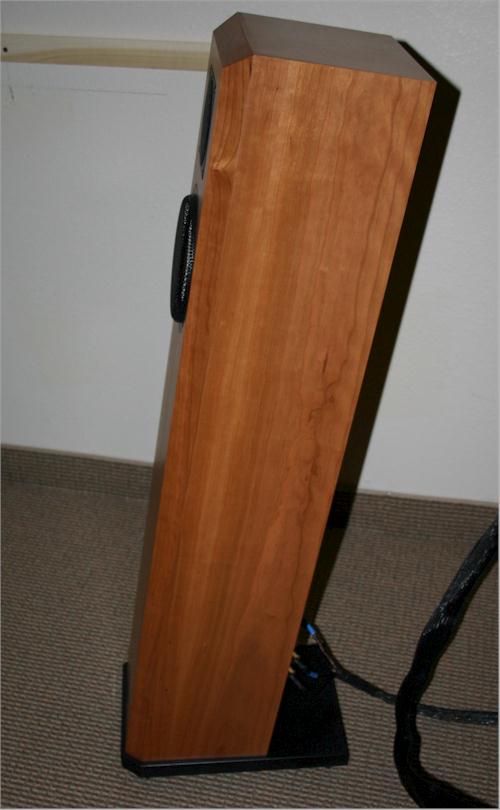 |
Oskar Heil Room
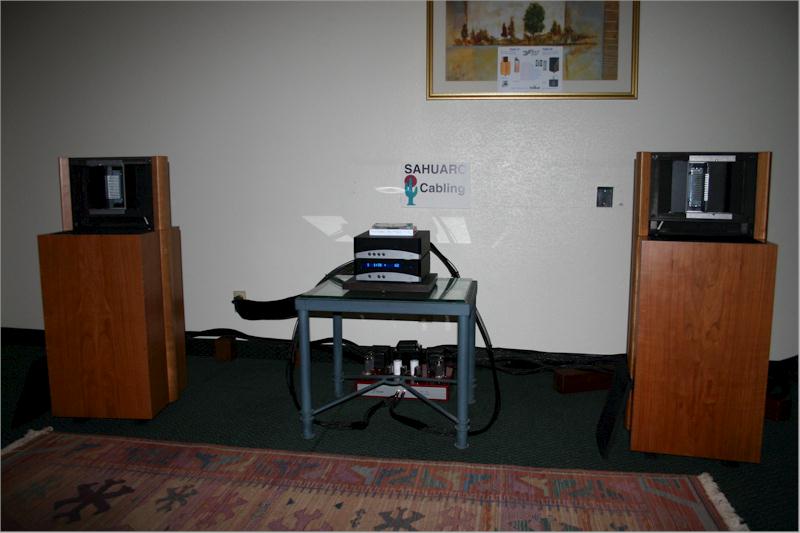
Oskar Heil Kithara hybrid speakers, various small tube amps, various CD
players
|
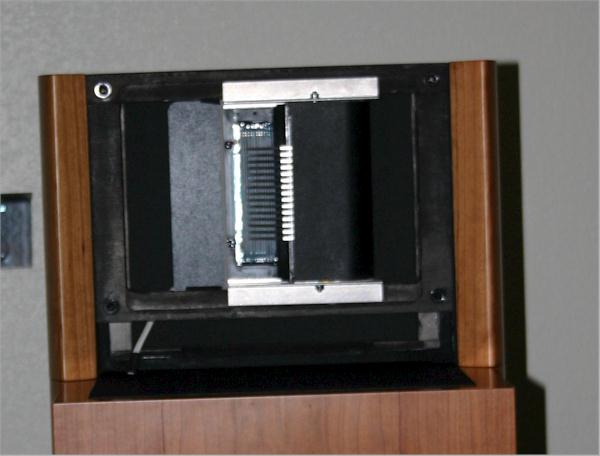
A closeup of the Heil AMT driver
|
Pleasantly detailed
sound with good imaging, soundstaging and micro-dynamics. Missing the
last word in macro-dynamics and bass texture and slam. Uses a
ribbon-like Heil driver for frequencies above 700 Hz.
We heard this system
with two different CD players and two different tube amps - and in two
different speaker placement configurations - and the intrinsic
musicality of the speakers always showed through.
Speakers of this
finesse usually cost three to four times more than the around $4K
these speakers retail for. Not sure why these aren't being snapped up
left and right, unless it is because of their unconventional
technology and appearance. |
| |
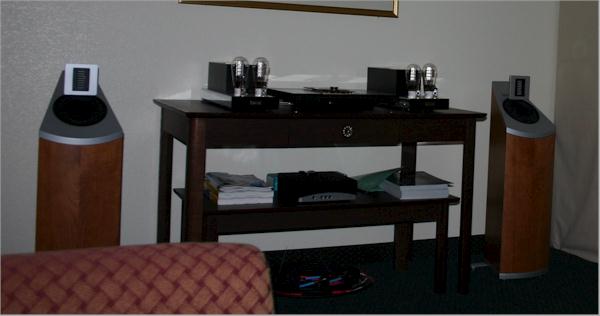
The Oskar Heil midsize speakers
|
|
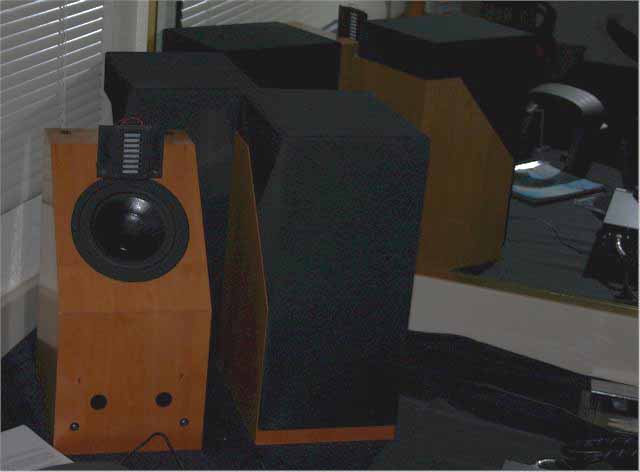
The Oskar Heil monitor speaker
|
|
Von Schweikert Room: Von
Schweikert / VAC
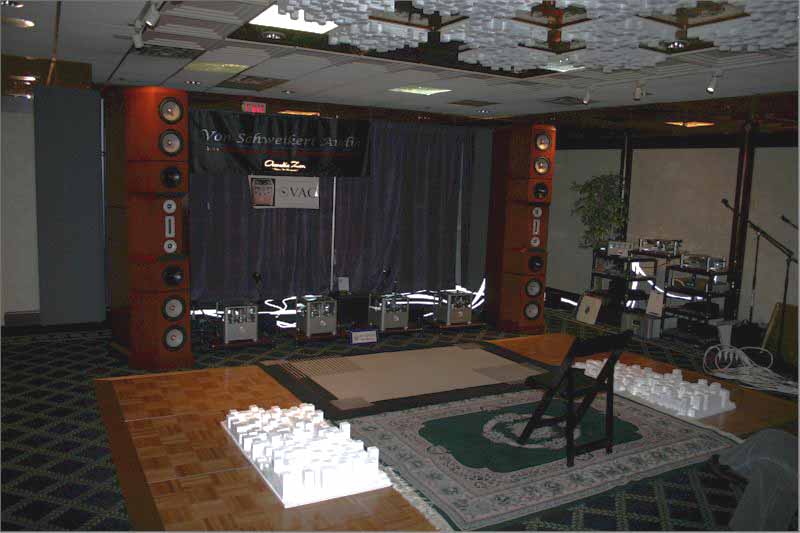
Very big sound with good
imaging, soundstaging depth, and macro dynamics. The speakers themselves
are attractive and come apart in 3 pieces and the overall weight of each
is a mighty 1100 lbs or so. Though possessing lots of authority vis-à-vis
macro-dynamics, this system was missing the last word in micro-dynamics
and so did not quite sound like the sound of real instruments. Also
missing some finesse and, though the soundstage was engrossing, did not
draw us into the music as well as perhaps it might have.
|
Our listening session
was primarily vinyl-based.
We apparently missed a
demonstration of live musicians in the room who were recorded and
played back through the system. It takes guts to put one's system to a
test, in public, like this. Kudos to the Von Schweikert team. |
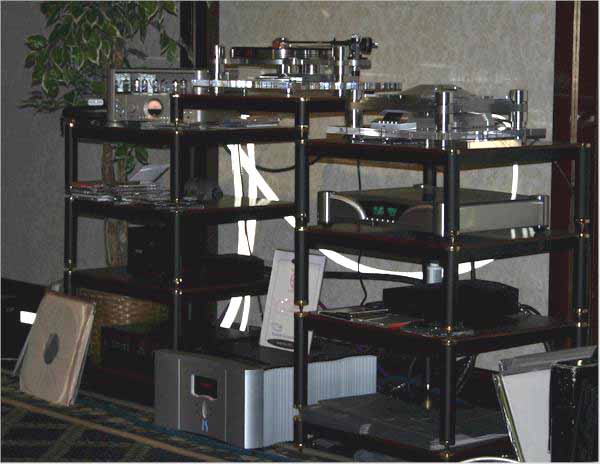 |
Audio Note U.K.
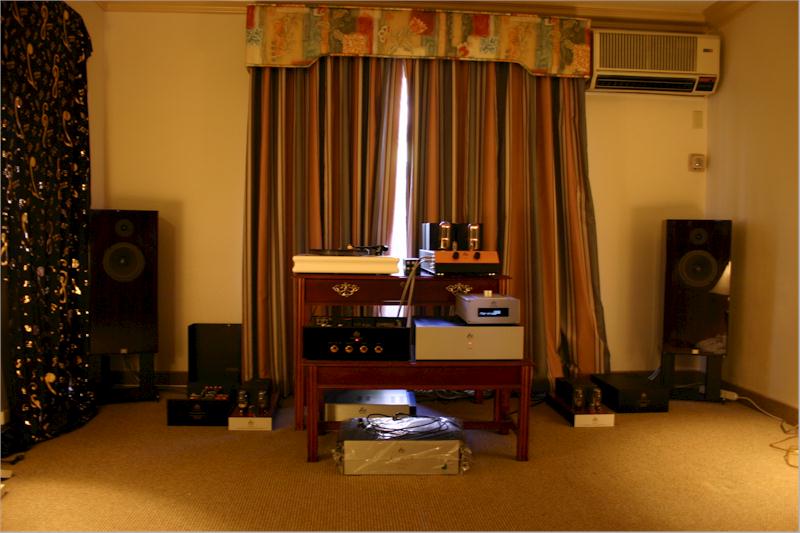
Musical yet accurate,
detailed yet romantic, classical music played effortlessly with no
collapsing of the soundstage nor rendering of detail into a wall of
sound. We thought, however, that this system lacked the fullness and
macro-dynamics that a midsize or large speaker would bring.
This was one of a
surprising large number of systems that used hotel furniture as equipment
racks. There was even someone using a cardboard box as a platform for an
Audio Aero CD player (don't worry, we won't say who :-). Not sure if this
says something about the cost of equipment racks, the size and weight of
equipment racks, lack of planning, or just about the overall confusion and
chaos that sets in when trying to setup a complete (and good sounding!)
system in one day (and night). Or perhaps the exhibitor is just making a
statement (as seems to be the case in this instance vis-à-vis Audio Note
U.K.).
|
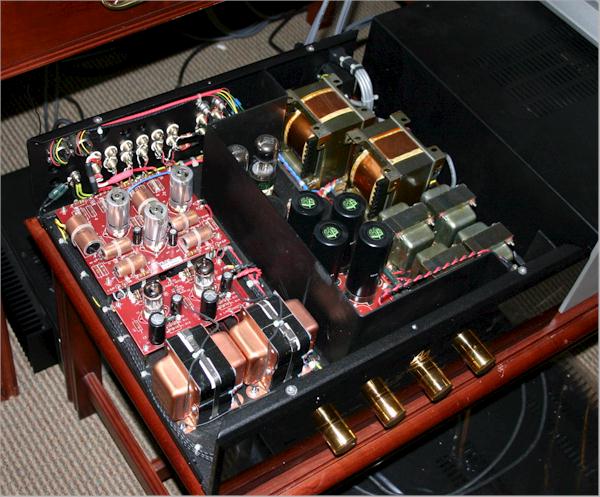
The inside of the M8 preamplifier
|
|
| |

The inside of the AN-E Special Edition Cobalt external
crossover and the Kageki amplifier
|
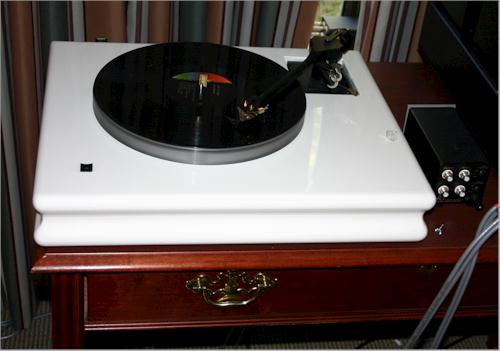 |
These furniture and
floor based systems were quite common at the T.H.E. Show at the St.
Tropez as well. Did we notice a real problem? No.... but there is
little doubt that the sound could have been improved in these rooms
with some attention to vibration control. |

The Beautiful glow of the Ongaku
Acoustic Dreams Room: Lumenwhite / Ayon / DCS
/ VYGER

This is the best we have
heard the Lumenwhites sound. Very pure and detailed, with plenty of PRaT.
THE DCS digital source equipment was almost able to keep up with the VYGER
turntable and ASR phono stage - the DCS was detailed, musical, good
dynamics up and down the scale, a nice pure sound though not as pure as
the EMMLabs but with more finesse. Quite impressive and definitely a step
up from the previous generation.
The larger Ayons seemed to
have no trouble driving the Lumenwhite Whiteflame speakers and the
mysterious Millennium preamplifier (one of a handful in existence) seemed
to do a fine job of letting the music through (of which it is rumored we
will hear more about in the future).
Enjoyable, though not quite
as engrossing as the Audio Aero room or the Joule Electra /Joseph room and
the slightest bit hard sounding during massed transients.
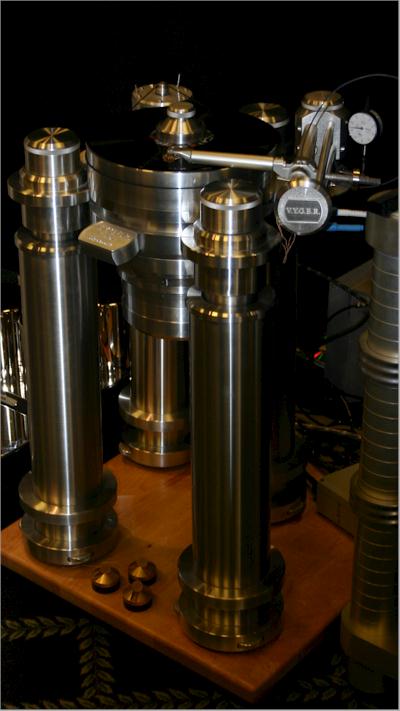 |
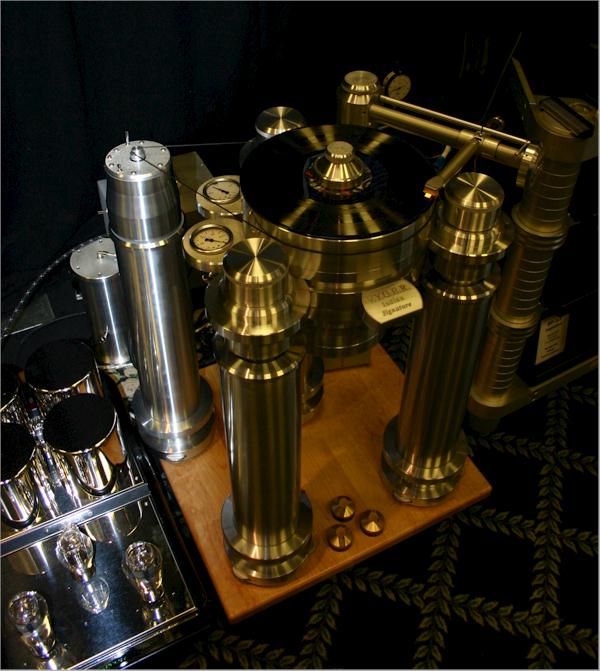
Various pictures of the VYGER turntable from Italy and distributed and
supported by Acoustic Dreams.
The gold color is picked up from the
reflection of the goldish carpet - the turntable in actuality is a
silverish color. |
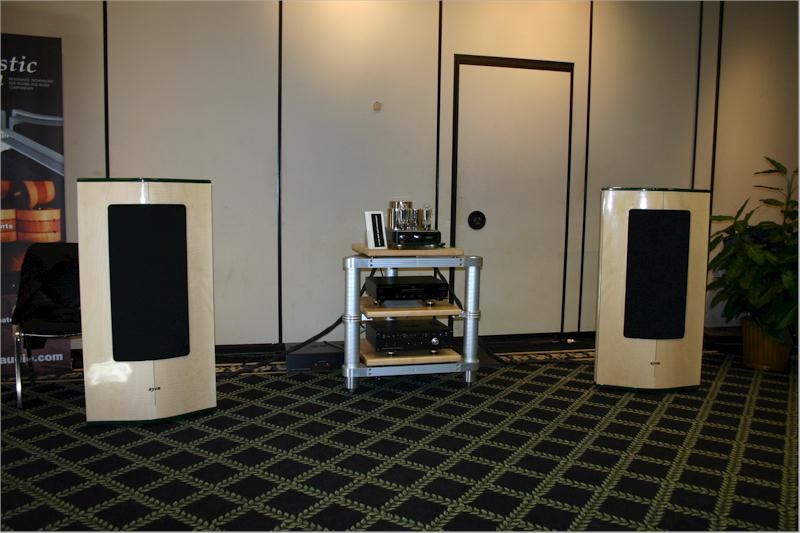
We did not get to hear the Ayon speaker system this year.
Tenor Room: Tenor / Kharma /
EMMlabs
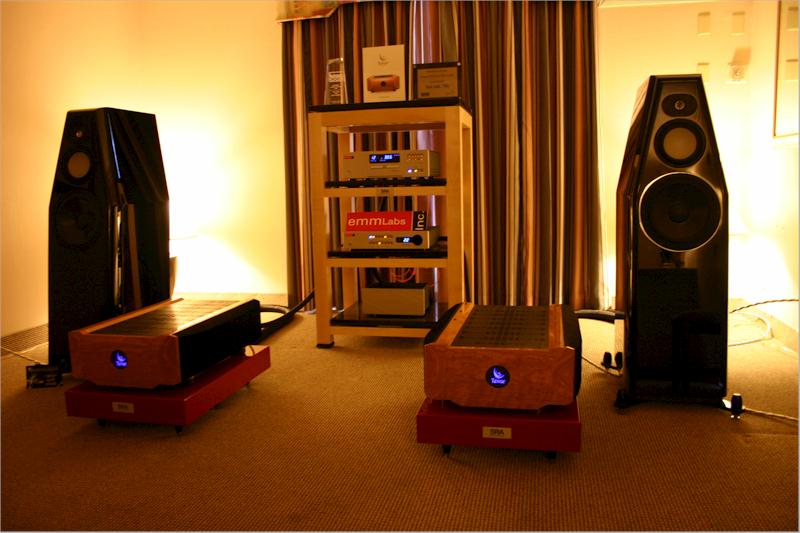
Nice sound, open, solid, pure, but missing a little of the air and detail
in the bass like most Kharma speakers and some of the magic of the same
system we heard at the Stereophile Show in San Francisco. Even so, this
system was easily a contender for Favorite of Show
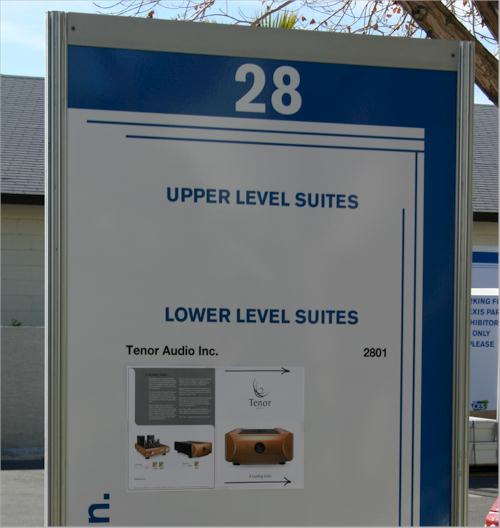 |
Tenor was way in the back
at the Alexis Park but we stopped there first anyway. Tenor (along
with Kharma and EMMlabs) has been setting the bar high at high-end
audio shows lately - and we wanted to get our 'ears tuned' from the
get go. |
|
The Tenor 300 watt hybrid 300HP
monoblock amplifiers are out of the prototype stage and now available. |
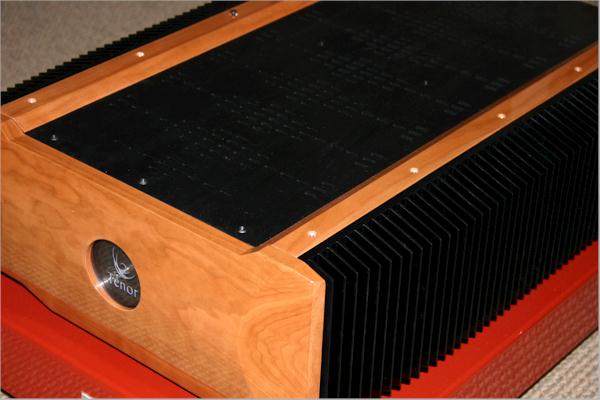 |
 |
The EMMLabs DCC2
transport you see here was a prototype.
Also used was the EMMLabs DCC2 DAC and
Shunyata Hyrda-8. |
GTT Audio Room: Lamm / Kharma
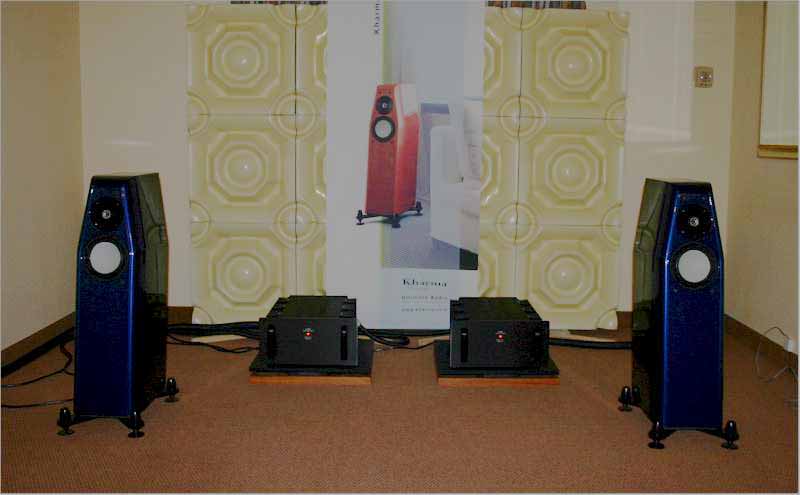
Detailed and dynamic, a nice solid performer, up and down the audiophile
checklist within the limitations imposed on the system by the size and
character of the Kharma 2-way speakers. Missing some air and that
fullness/completes of the lower midragne that comes from having a woofer.
No collapsing of the soundstage on large orchestral pieces.
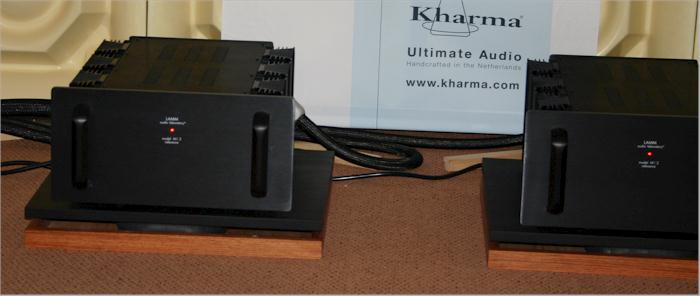 |
The M1.2's really open
up the Kharmas -- the soundstage was broad and deep, no collapsing
ever, somewhat more neutral than the same system using Lamm ML2's
(which we have heard at numerous previous shows). |
|
And the bluish panels
of the Kharmas weren't none too shabby either :-) |
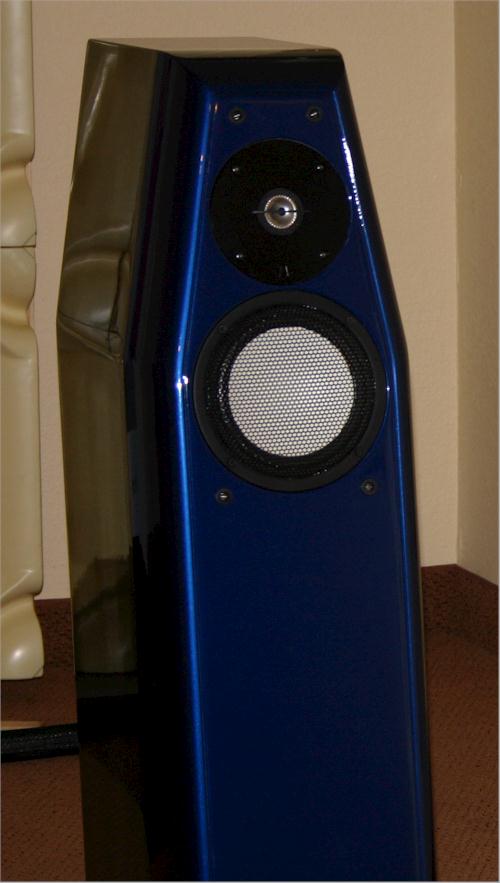 |
Gilmore room #1

Lack of soundstage depth, collapsing on loud/complex passages into a harsh
wall of sound, harsh midrange, less micro and macro dynamics than most
systems. The fit and finish of the speakers was also less than what we
were expecting.
|
After the massive
advertising campaign we were expecting to hear something that, though
perhaps a little rough (being so new), would have been impressive in
some manner or form - so this was a disappointing room. |
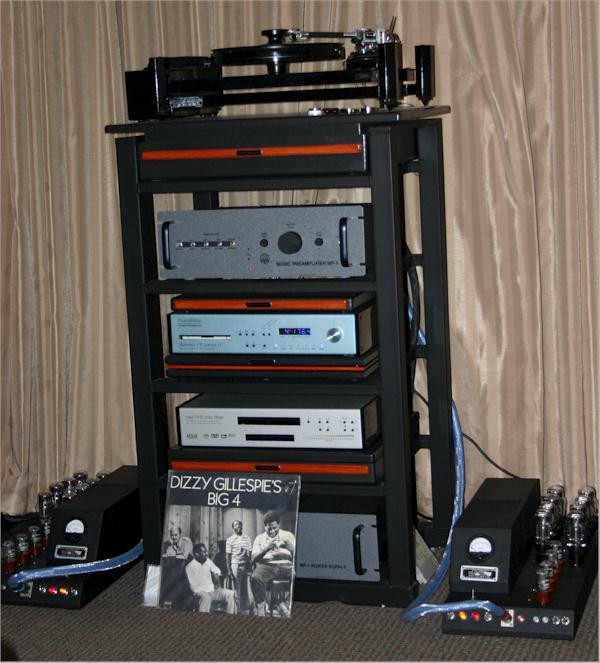 |
Gilmore room #2
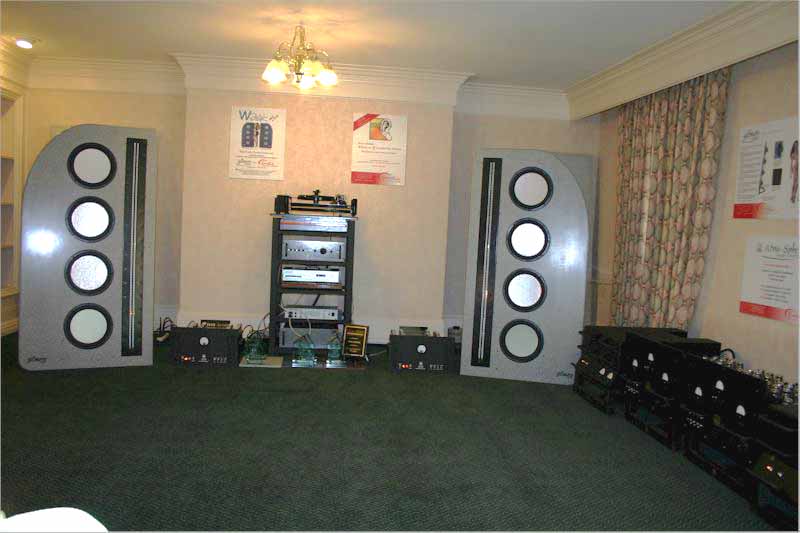
Better than room #1, we did not listen long enough to determine the
relative quality of this rooms sound vis-à-vis the other rooms at CES
|
A truly impressive array of Atma-sphere
amplification behemoths. |
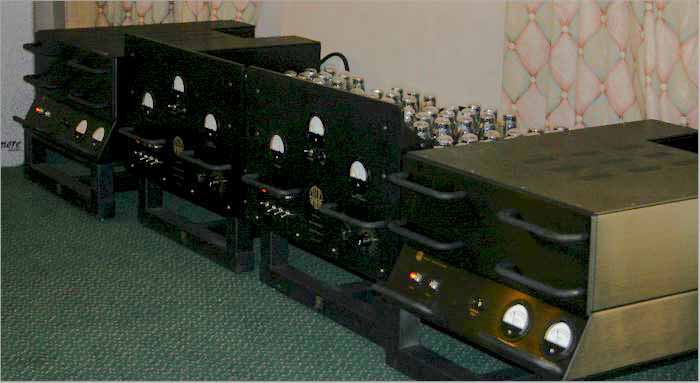 |
Epiphany / Audio Aero / Orpheus
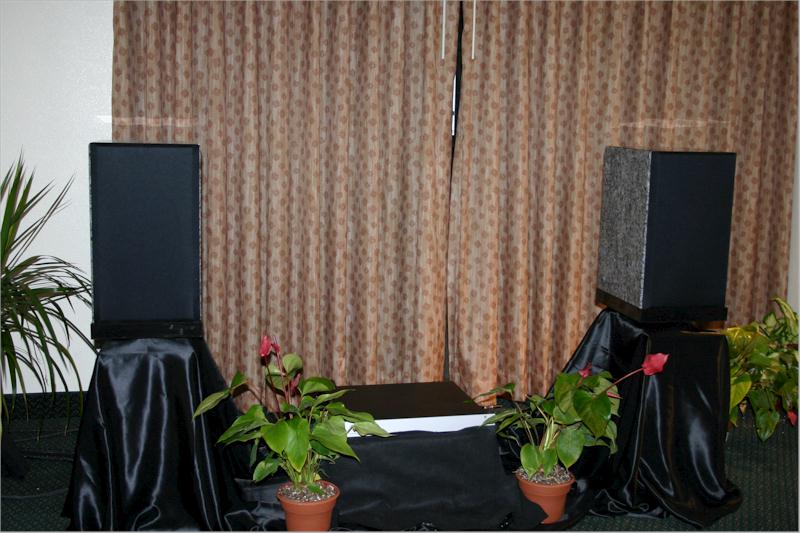
Weighing in at around 50
lbs, these around $3,500 granite encased largish monitor speakers had a
fullness and depth of soundstaging and macro-dynamic that was impressive
for their size and price. Tonally accurate, the system had a wide sweet
spot. We heard this system driven by an Audio Aero Capitole MK II with 4
hours, yes, hours, on it, graciously loaned to Epiphany by Globe Audio
Marketing/Audio Aero, along with a 40 watt Orpheus amplifier, also loaned
to them by Globe Audio Marketing/Orpheus. This is because the day before a
different CD player that they were using, of an unspecified brand, had
blown, taking the previous amplifier and much of the speaker circuitry
with it. So, with all this, the newly rebuilt speakers were sounding quite
good - and a bargain at their price.
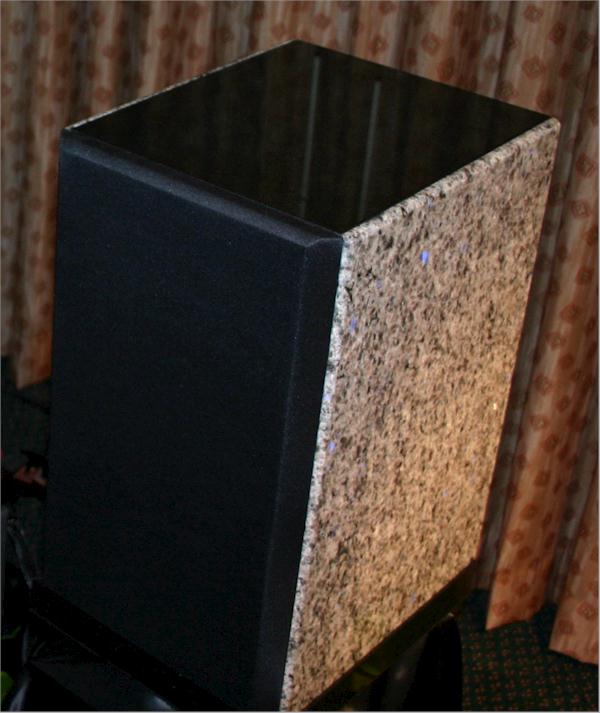 |
Gearing their
appearance to fit many modern decors, the lack of resonance of these
solid granite speakers with a conventional 6 inch driver plus tweeter
apparently goes a long way towards remedying the ills of most speaker
designs.
Here we can see the
lovely blue flecked granite used for the sides of the speaker and the
elegant piano black granite for the top. |
MBL Room: Reference system
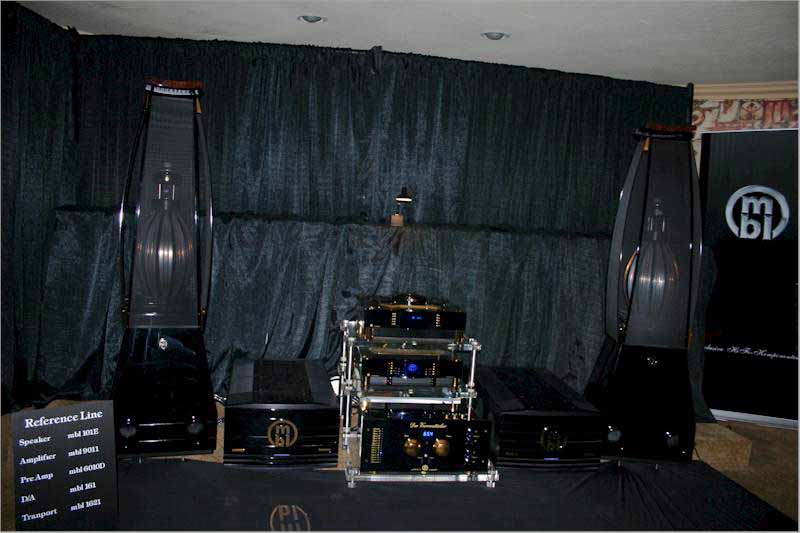
A smooth sound,
macro-dynamics and authority in spades, missing a touch of micro-dynamics
and the 'sharp edges' that some notes require to sound 'real'. This was
another odd-sized room, quite small, and the system was positioned on top
of a hot tub and sharing the room with a curtained-off shower. The lights
were off and the system was illuminated with a couple of glowing red
lights. There were about 3 chairs, and standing room for 2 or 3 behind
them, situated about 5 feet in front of the speakers. It was played loud,
yet the purity of the sound was such that it probably could have been
played even louder without stressing our ears. Very atmospheric, in a
somewhat 'late sixties meets the future' kind of way.
MBL Room: Small system
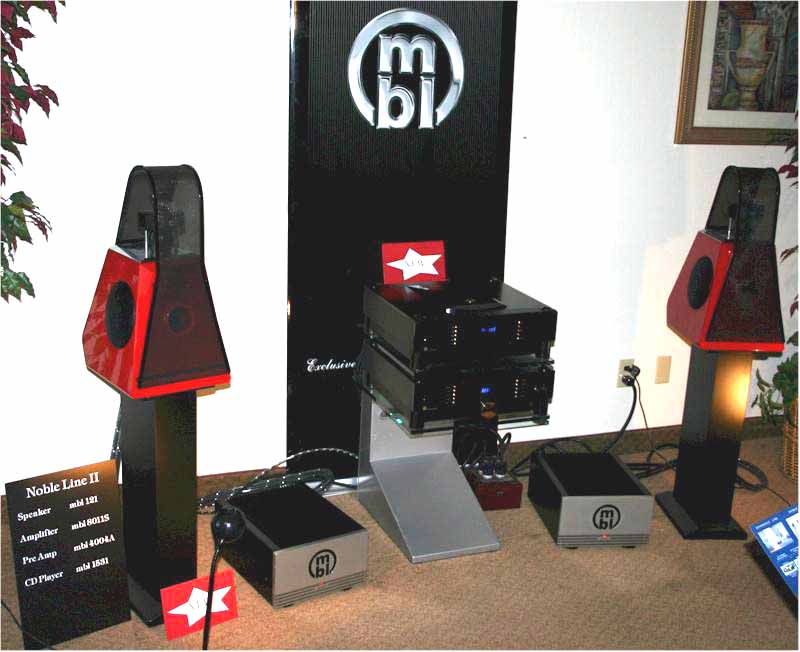
This system had a smooth sound, detailed,
pleasant to listen to with good soundstaging and large sweet spot.
Audio Note Kondo
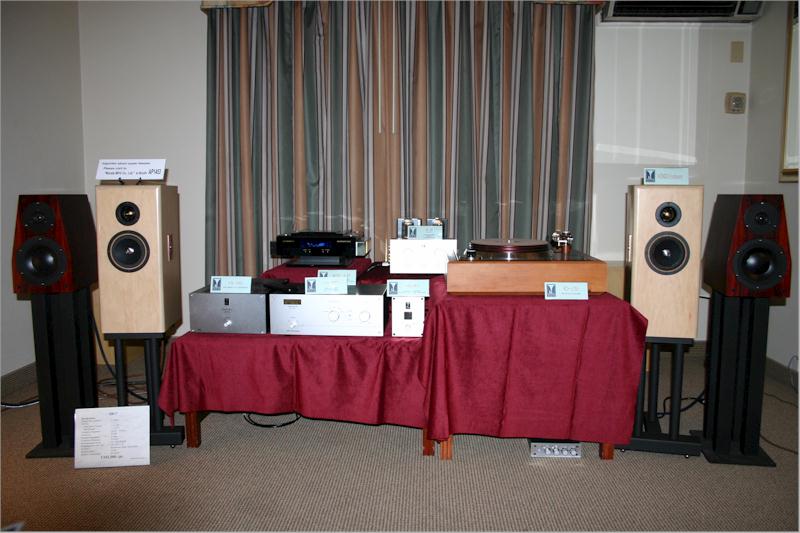
We felt the smallish, monitor speakers used once again limited the body
and dynamics and even warmth of the sound in this room.
JM Reynoud / ASR
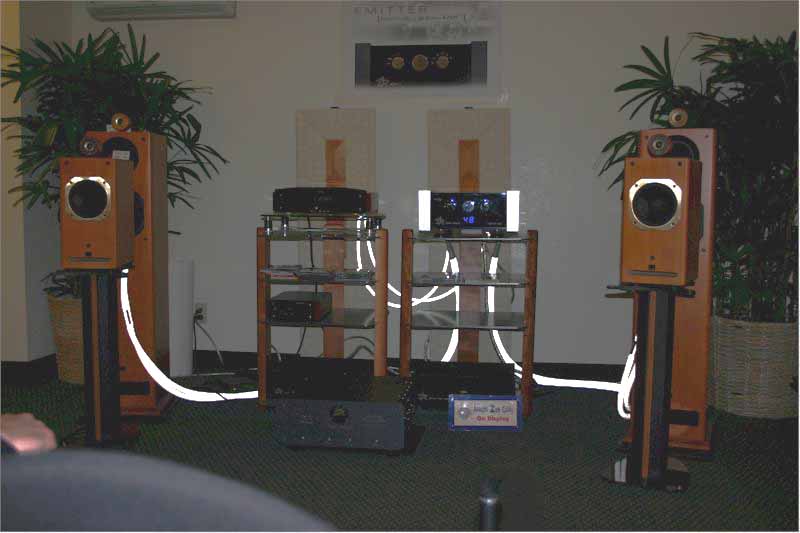
These monitor speakers are
slightly sweet, evidencing tons of inner detail and finesse. Like with
most monitor speakers, bass and fullness are not in evidence.
Almarro Room #1 (small speaker
system)
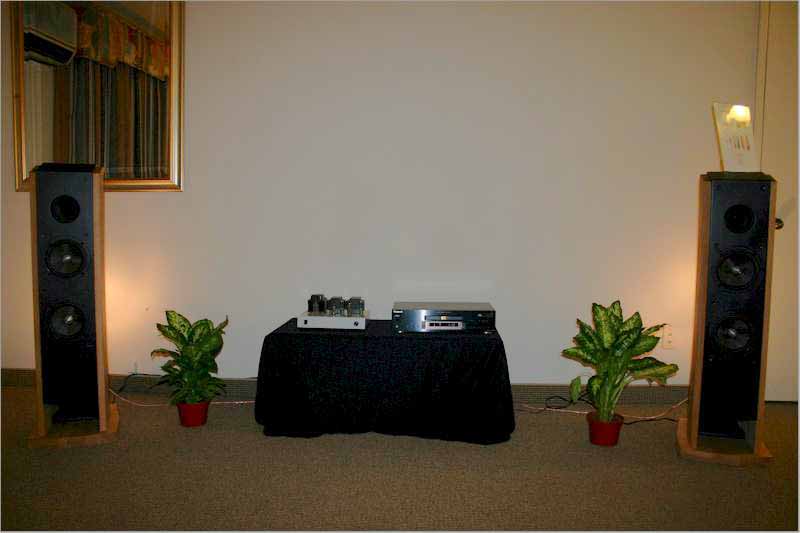
Pleasant and musical with lots of 6C33C tube flavor. While missing the air
and bass dexterity (and overall finesse and authority) of the more
expensive systems - this system is still able to communicate more of the
music than most other systems costing 10 times as much. Using cheap cables
and OEM Belden power cords, and an apparently un-modded inexpensive CD
player, Almarro appears to be making a statement about what can be done
with an extremely small budget (with respect to the rest of the systems at
CES). Again, because of the relatively low price of this entire system
(~$4K) and because it is holding its own against the big boys, those on a
budget should have a listen.
Almarro Room #2 (large speaker system)
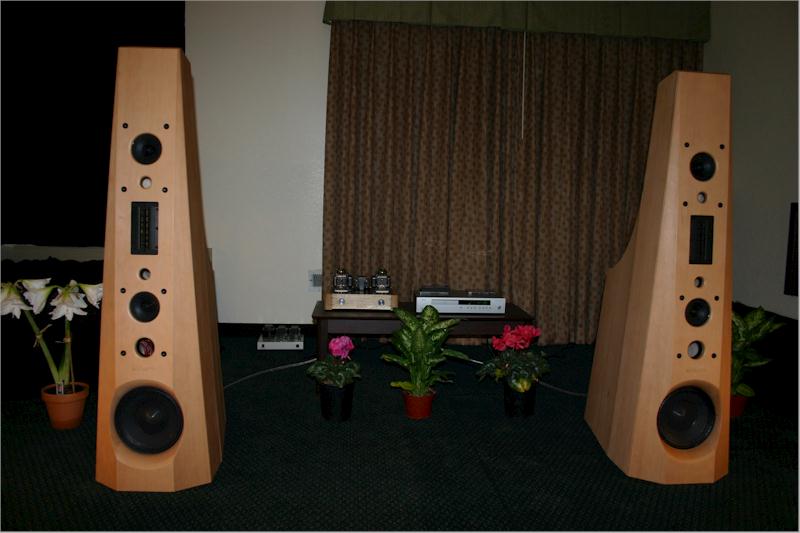
Lack of top to bottom integration and compressed dynamics led us to prefer
room #1
Musical Surroundings Room:
Acapella / Clearaudio
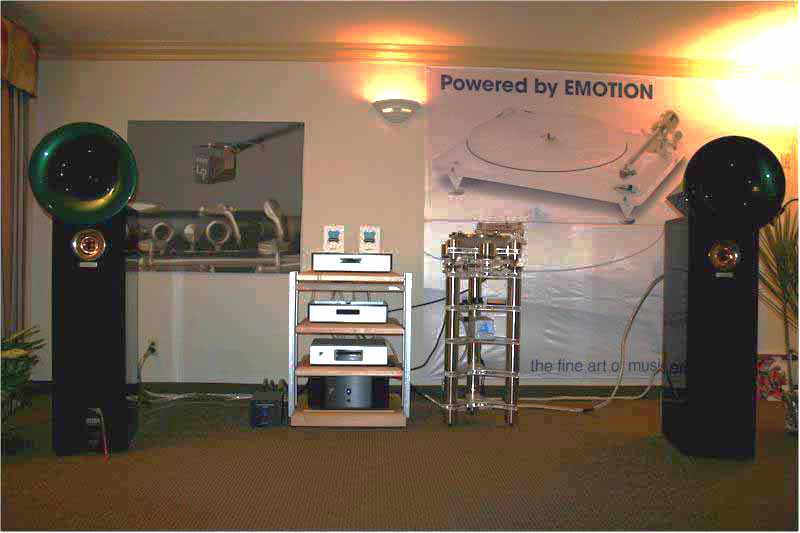
Nice sound, big, real,
timberly pure, harmonically rich and enjoyable to listen to. Missing the
last word in macro dynamics and authority. This is the first time we have
heard the Clearaudio amps, and their being solid-state and all, we were
pleasantly surprised that they were quite musical and smooth.
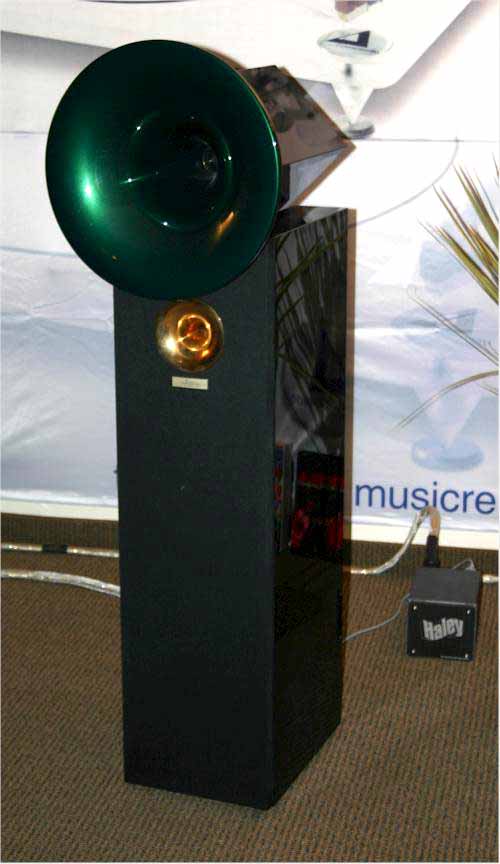 |
We liked the green horn
color for the Acapella Violons - it being the cheerful type of green
versus the gloomy forest type or hygienic hospital type. Hermann
Winters of Acapella was on hand to answer any questions. |
tmh Audio Room: Wavac / Talon
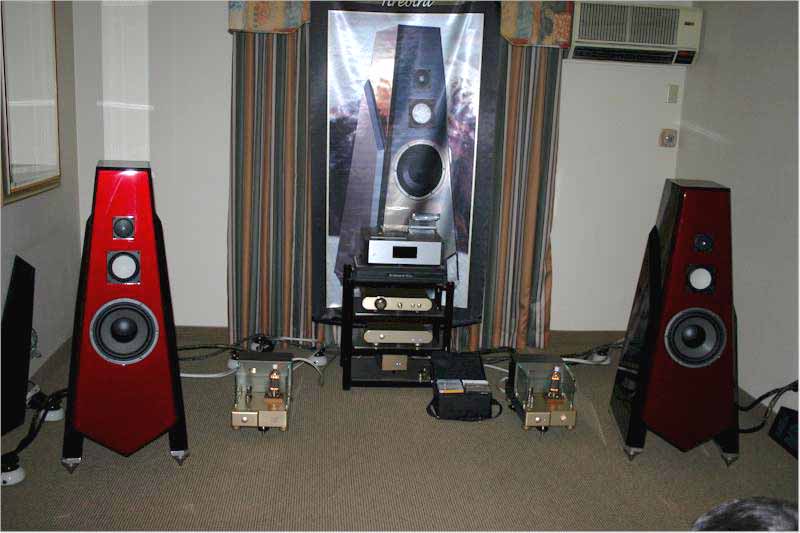
Detailed with lots of
finese, good timbre and open and musical. Just on the warm side of
neutral. Lack of bass control was evident on these relatively hard to
drive speakers.
tmh Audio room: Wavac / ESP
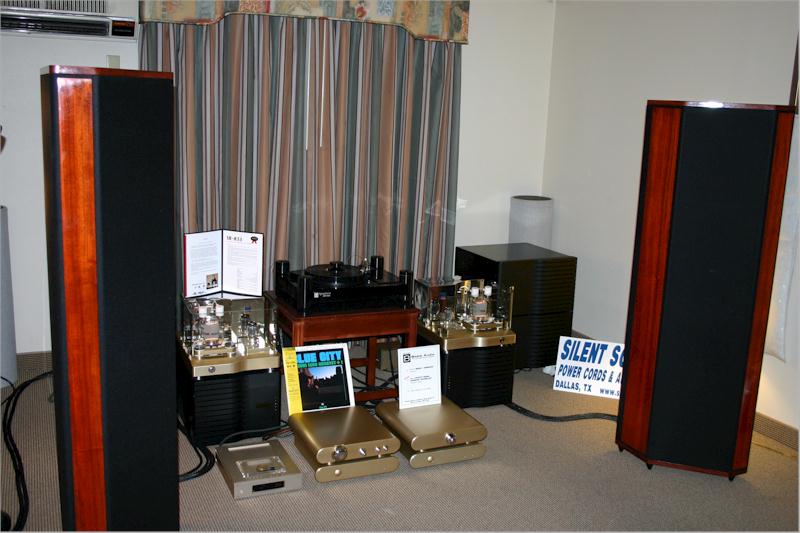
$350K amps anyone? Wavac
introduced their new SH-833 150 watt 8 piece monoblock amplifiers.
Above 1000 Hz this system
had a dynamic that reproduced piano better than anything yet heard by this
reviewer. The Marten Design Coltranes paired with the Edge Signature One
monoblocks produces a very convincing piano (and guitar) sucking the
listener into the reality of the original recording session. The big Wavac
seemed to do this one step better, with somewhat more harmonic richness
and slightly more accurate leading edge of the note envelope.
| |
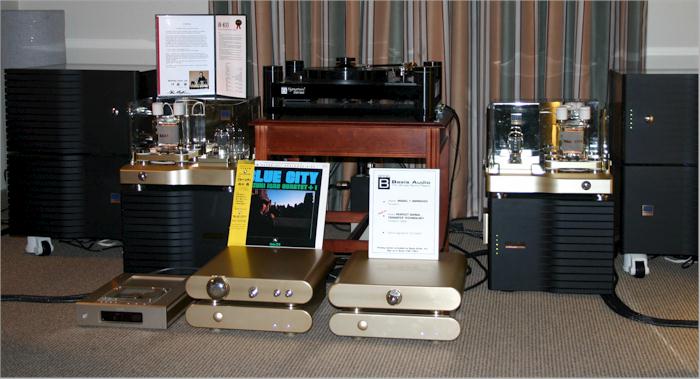
This 'getting the note envelope dynamic correct' is a important thing
- it is the one area where audio reproduction usually fails miserably
(and most horn systems that come close are not able to reproduce the
many other important cues that make a convincing reproduction). If you
ever listen to a piano, you will notice how quickly the note goes from
nothing to being very loud. This is part and parcel of the excitement
of music - the wondrously rich birth of notes in various sequences and
harmonies. This authority of execution the big Wavac has in spades.
Below 1000 Hz this
system was bloated and congested and nearly unlistenable. |
Chapter / Talon / HRS

We liked the sound of this
system, coming to believe as we do that the Talons are best driven by high
quality solid-state amplification. The sound was detailed and pure, bass
was well controlled. There was some slight lack of involvement with this
system.

Walker / Viva / Zingali

An amazing amount of
detail, especially with large orchestral scores, that were not heard
elsewhere. Good soundstaging and macro-dynamics, missing some overall
finesse and evidencing some compression and 'beamyness' in the midrange of
the speakers. To say the $13K speakers had a hard time keeping up with the
almost $100K system would be stating the obvious - but for all that they
hung in there like troopers.
 |
The Walker Audio turntable handles
the massive amounts of information during big band and orchestral
pieces with aplomb.
The Zingali did a good job at
keeping up with this aspect of the music, not collapsing the
soundstage during climatic pieces.
Here we see the Walker 'table on top
of the Walker rack, along with their motor controller and phono stage.
Also seen is the Viva preamp. |
| |
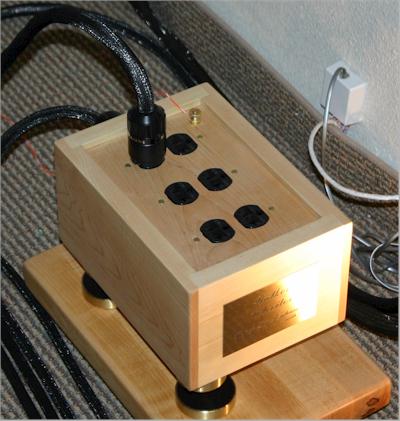 |
The Walker Audio Velocitor, used to
filter the power. |
| A Viva monoblock amplifier |
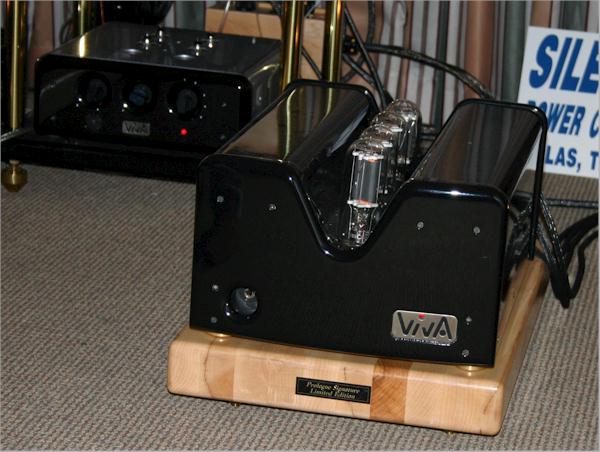 |
Alon, ASL
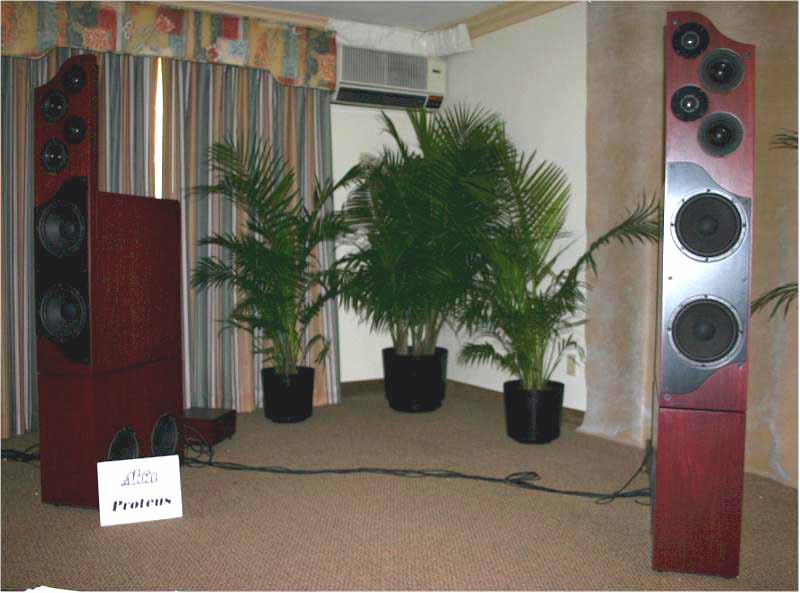
Introducing the new $45K
Alon Proteus speakers. Lack of inner detail and micro-dynamics and bass
control made this system which was often played WAY TOO LOUD not very
engrossing. Pretty sound (but not as pretty as the Accuphase room) but
somewhat 'blurry' and not very real.
| |

Precision VII turntable with Miyabi MC cartridge,
Triplaner MK VIII arm and the Conrad Johnson Art two-box preamplifier
|
| |

The ASL Hurricanes
|
Axiss room #1: Accuphase, Transroter

Sweetness and light
sounding nothing like real instruments but very pretty sounds none the
less. We met the nice gentlemen from Accuphase / Japan and have to admit
that the overall visual aesthetic was very impressive. They are
introducing a new preamplifier that has taken the volume control
completely out of the signal path (putting a servo-controlled(?) device in
the path instead). Something new for the rest of the industry to look
into.
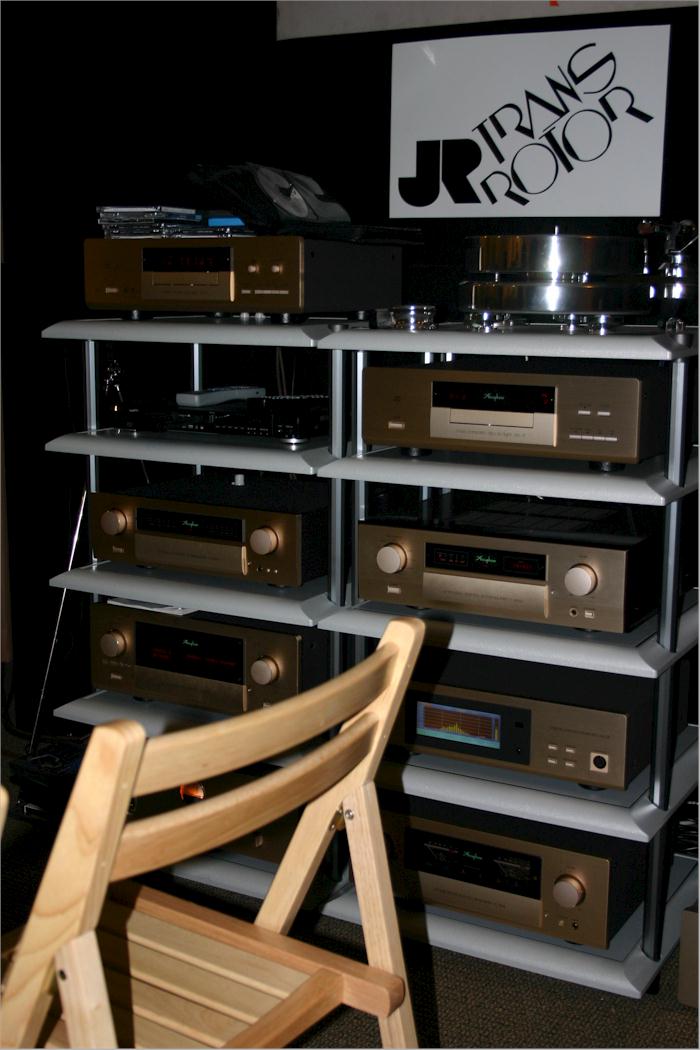
Audiopax, Zanden
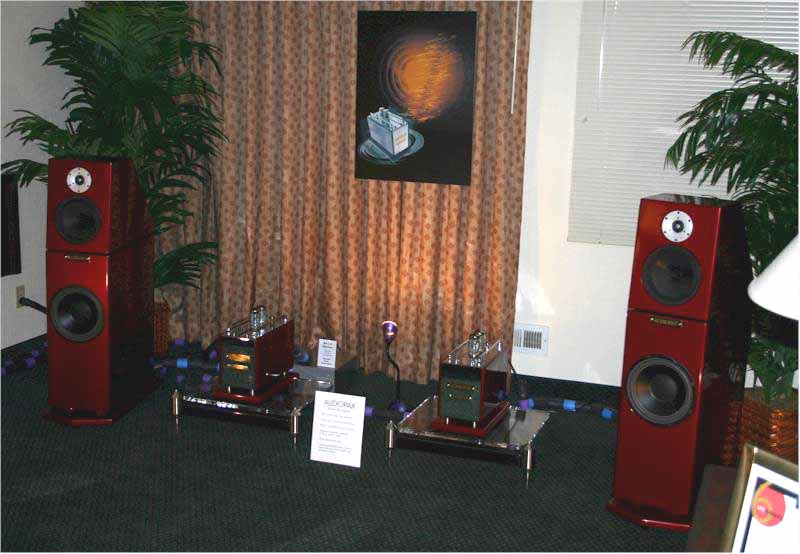
Very nice, very refined.
Audiopax now has speakers, apparently, and the system sounded very good.
Very attractive as well. We did not get to spin a disk in this room,
unfortunately, but what we heard made us want to hear more next year.
Kuzma / Tom Evans / Lowther
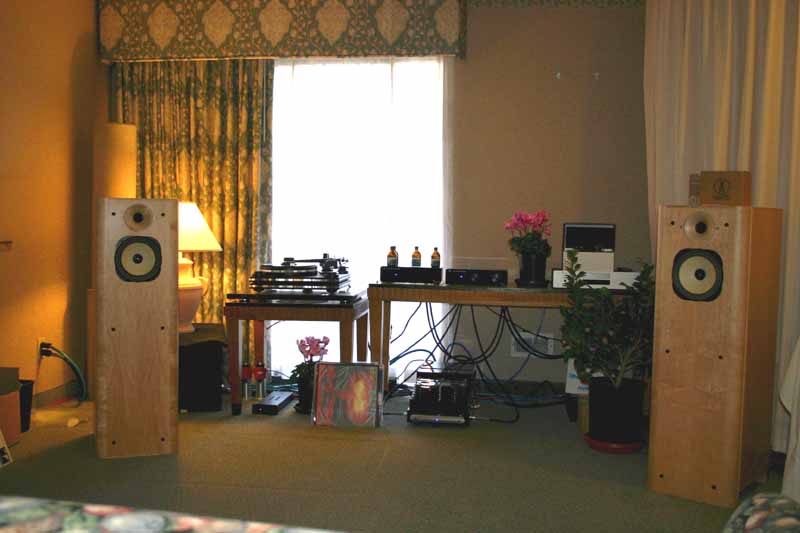
Nicely detailed and involving midrange and highs - missing bass, bass
control and bass detail.
Mantra

Dynamic and uncompressed,
but lacking finesse and collapsing the soundstage on complex passages.
Always aware that the sound was created by large PA-type horns
Edge Room
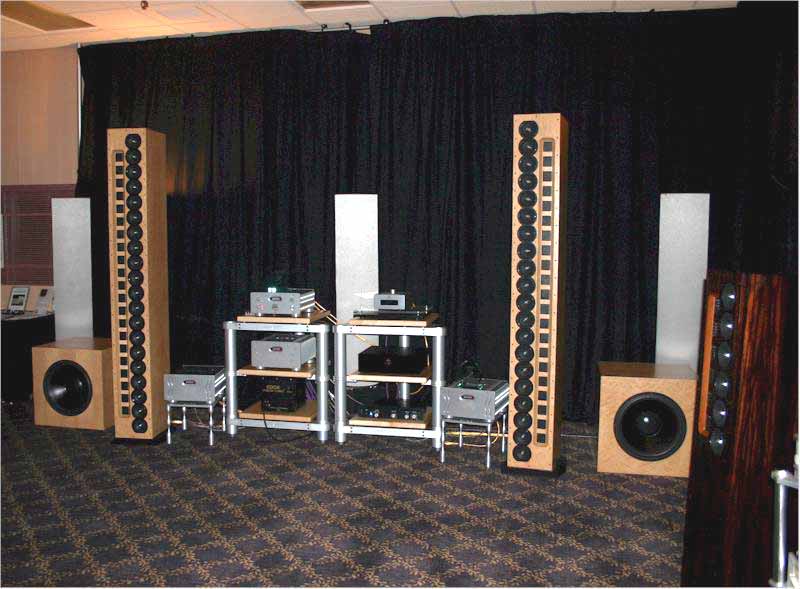
The speakers are similar in
appearance to the Pipedreams speakers, and the sound in this room had
similar sonic characteristics to other systems that may have
Pipedreams-style speakers: nice big sound, lots of macro-dynamics and bass
authority, but with a lack of the inner detail and micro-dynamics that is
needed to make music involving and to invoke emotions in addition to the
adrenaline-based ones..
There were three systems
set up in this, one of the large rooms at the San Remo - one with tall
speakers, one with medium high speakers, and one with short (around 4 feet
or so) speakers.
The electronics in the room
ranged from the Edge Signature One monoblocks and Edge Signature One
preamplifier, to a system powered by the new Edge G3 integrated amplifier
(very musical yet neutral, detailed yet smoothly continuous, ...and with
knobs that glow in a discrete bluish color).
tmh Audio room: Soundlab / Vitus
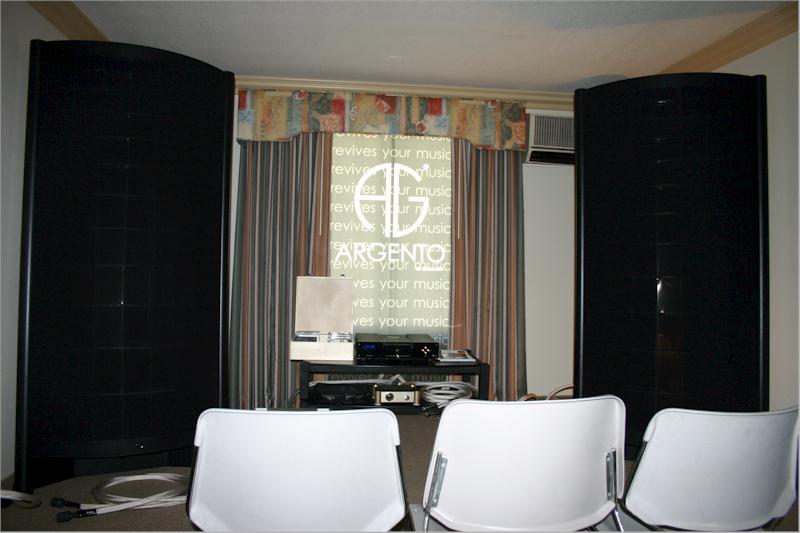
Nicely detailed and open
sound, good soundstaging, both macro and micro-dynamics quite good.
Control of the speakers was excellent, and the separation between notes
contributed to a very low noise floor. There was a little harshness in the
midrange and brightness in the treble which gave the overall sound a
solidstate' and 'digital' character. There was also a slight lack of inner
detail.
|
These amps certainly look
like they can control any speaker.
Driven by an Electrocompaniet CD
player. |
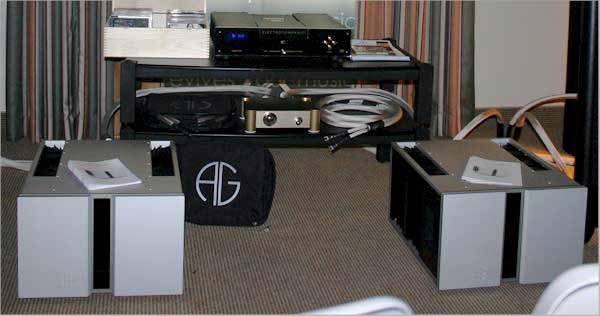 |
Merlin Room: Merlin / CAT / Audio
Aero
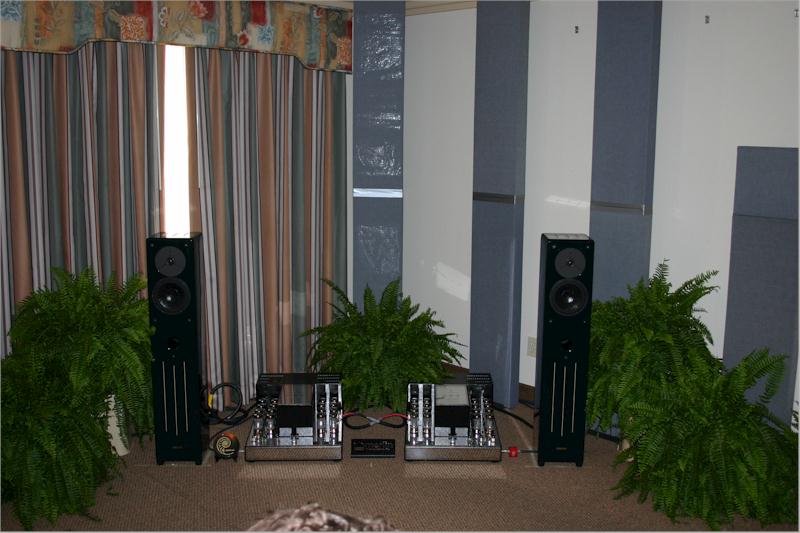
The amps seemed to have gobs of control and authority over these speakers,
but there was a lack of finesse and a somewhat boxy sound. Also appeared
to be missing some midrange frequencies and some air as well.
Favorites of Show
Some of the questions we ask ourselves when we listen is: could we live
with this? How much do we want to take this system home with us? But the
main question we ask ourselves is: are we enjoying this? Does the sound
seduce us into staying in the room longer than we really should have? Note
that this type of ranks 'merely' competent systems (like the GTT Audio
Lamm / Kharma room, the Marten Design / EAR room, and the Tenor / Kharma
room) behind more musical (and lush) rooms like the Joule Electra / Joseph
Audio room and Audio Aero room.
A few thoughts about why we
chose the Joule Electra / Joseph Audio room as our Favorite of Show: in
the past we have been frank about what we thought about the overall lack
of musicality and other severe problems in the Joseph Audio rooms of past
shows, as well as intrinsic problems with the speakers themselves. Our
opinions have not changed - but this particular system, this year,
was of a whole that actually worked together to get the most out of the
individual components. Each of the pieces have weaknesses that could
cripple an entire system, but here the weaknesses played off each other,
like jazz musicians, and so this system worked. Kudos to the people
who set up the room.
Big speaker systems
Joule Electra / Joseph Audio room
Musical Surroundings Room: Acapella / Clearaudio
Acoustic Dreams room
GTT Audio Lamm / Kharma Room
Wavac / Talon Room
Lamm Room
Marten Design / EAR room
Tenor / Kharma
MBL (reference system)
Talon / Charter
Small speaker systems
Audio Aero Room
Oskar Heil Room
Epiphany Room
JMR Room
MBL (small system)
Almarro room (small system)
Back
to Our Main CES 2004 Page |
